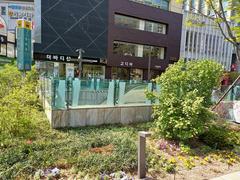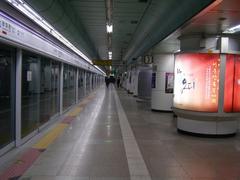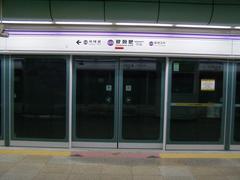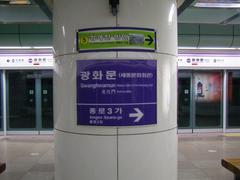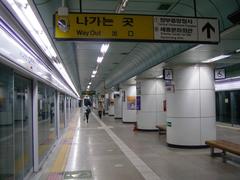
Gwanghwamun Station Visiting Guide: Seoul Historical Site Tickets, Hours, and Tips
Date: 15/06/2025
Introduction
Gwanghwamun Station, centrally located in Seoul, is far more than just a transit hub—it’s a gateway to the city’s most iconic historical sites, vibrant cultural experiences, and picturesque public spaces. Anchored by the majestic Gwanghwamun Gate—the main entrance to Gyeongbokgung Palace—this area embodies Korea’s royal legacy and its ongoing cultural vitality. Whether you’re a history enthusiast, a culture seeker, or a casual traveler, this guide will equip you with detailed, up-to-date information on visiting hours, ticketing, accessibility, nearby attractions, dining, shopping, guided tours, and seasonal events. With helpful tips and official resources, you’ll be ready to make the most of your journey through one of Seoul’s most treasured districts.
Historical Overview and Cultural Significance
Origins and Historical Evolution
Gwanghwamun, first constructed in 1395 under King Taejo of the Joseon Dynasty, has long stood as a symbol of royal authority and Korean resilience. Its name, bestowed by King Sejong the Great, is often interpreted as “the Gate of Enlightenment,” reflecting its purpose as the southern portal to Gyeongbokgung Palace and the heart of the capital (Wikipedia). Over centuries, the gate has suffered destruction—from Japanese invasions to occupation-era relocations—but has always been rebuilt, most recently in 2010 using traditional methods to restore its original wooden grandeur (Cars Scanner Blog; Wikipedia).
Architectural Features and Symbolism
Gwanghwamun’s architecture reflects the elegance of Joseon-era design: a stately three-arched gateway crowned by a two-story wooden pavilion, flanked by stone statues of haetae (mythical lions signifying protection). Its location on the main axis of Sejong-daero, aligned with Gyeongbokgung Palace, underscores its ceremonial and symbolic importance. The surrounding Gwanghwamun Square is landscaped with gardens, fountains, and engraved stones, creating a space that is visually impressive and historically meaningful (Gwanghwamun Official Site).
Role in Korean History and Identity
Gwanghwamun has served as the backdrop for royal processions, state ceremonies, and pivotal moments in Korean history. It has witnessed both national crises and the renewal of Korean identity, especially through its repeated reconstructions, which are seen as acts of cultural resilience. Today, it remains a focal point for civic events, peaceful demonstrations, and cultural celebrations (KoreaTripAdvisor; KKday).
Living Heritage and Modern-Day Relevance
Gwanghwamun is not just a static monument; it’s a living cultural hub. The area hosts reenactments of the royal guard changing ceremony, public festivals, and interactive exhibitions. Statues of King Sejong the Great and Admiral Yi Sun-sin honor two of Korea’s most influential historical figures, while modern installations, open lawns, and fountains invite both reflection and community engagement (Trip Korea; KoreaTravelPost).
Visitor Information: Hours, Tickets, and Accessibility
Visiting Hours
- Gwanghwamun Square and Gate: Open 24 hours daily, year-round.
- Gyeongbokgung Palace: Typically open 9:00 AM–6:00 PM (last admission 1 hour before closing); closed on Tuesdays. Always check the official website for seasonal changes or special closures.
Tickets
- Gwanghwamun Square and Gate: Free admission.
- Gyeongbokgung Palace: 3,000 KRW for adults, with discounts for children, seniors, and hanbok wearers. Tickets available onsite or online.
Accessibility
- The area is pedestrian-friendly and wheelchair accessible, with elevators and ramps at key sites.
- Gwanghwamun Station (Line 5) and multiple bus routes provide easy public transport access.
Travel Tips
- Visit early morning or late afternoon to avoid crowds and enjoy optimal lighting for photos.
- Check the royal guard changing ceremony schedule, usually held twice daily.
- Wear comfortable shoes for extensive walking.
- Use a T-money card for convenient subway and bus travel.
Special Features: Tours, Events, and Photo Spots
Guided Tours
- English and multilingual guided tours are offered at Gyeongbokgung Palace and nearby sites. Tours provide rich historical context and can be booked onsite or through official tourism websites.
Special Events
- Look for cultural festivals, traditional performances, and public exhibitions throughout the year, especially during major holidays and the Seoul Lantern Festival.
Best Photographic Spots
- The front view of Gwanghwamun Gate for wide shots.
- Statues of King Sejong and Admiral Yi Sun-sin in the square.
- Early morning mist or nighttime illumination for atmospheric photos.
Nearby Attractions
- Gyeongbokgung Palace: Seoul’s grandest palace, with regular ceremonies and guided tours.
- National Museum of Korean Contemporary History: Modern history exhibits, free admission.
- Cheonggyecheon Stream: A peaceful urban waterway, great for walking and night lights.
- Insadong: Cultural district for crafts, art, and street food.
- Bukchon Hanok Village: Preserved traditional Korean houses and artisan shops.
- Samcheong-dong: Trendy cafes, boutiques, and art galleries.
- Jogyesa Temple: Central Buddhist temple known for lantern festivals.
- Deoksugung Palace and Jeongdong-gil: Western-influenced architecture and romantic walks.
Dining, Shopping, and Local Experiences
Where to Eat
- Traditional Korean: Try Gwanghwamun Hanok House or Gyodae Icheungjib for classic hanjeongsik or authentic BBQ (KoreaTravelPost).
- Modern & Fusion: Modowoo Gwanghwamun offers contemporary interpretations of Korean flavors.
- International Options: The area also features Japanese, Chinese, and Western cuisine (My Guide Seoul).
- Dining Tips: English menus are not universal—translation apps can help. Peak times may require reservations or patience.
Shopping Highlights
- Kyobo Book Centre: Korea’s largest bookstore, ideal for books and unique gifts.
- Souvenirs and Handicrafts: Head to Insadong for traditional paper, ceramics, and art (Seoulistic).
- Fashion & Beauty: Myeongdong and Namdaemun Market are easily reached by subway for K-beauty and bargain shopping.
Local Experiences
- Cultural Activities: Attend performances at Sejong Center for the Performing Arts or workshops in Insadong.
- Hanbok Rental: Dress in traditional attire for free palace entry and memorable photos.
- Cheonggyecheon Stream: Relax or join seasonal events along the waterway.
Nightlife
- Gwanghwamun offers a relaxed evening scene with illuminated palaces and stream walks. For more nightlife options, visit Jonggak Avenue of Youth, Itaewon, or Myeongdong.
Practical Visitor Tips
- Language: Basic Korean or translation apps are helpful; English is limited in some venues (HeyRoseanne).
- Navigation: Subway exits are numbered and signage is bilingual.
- Accessibility: Elevators and accessible restrooms are available at most major sites (Visit Seoul).
- Cultural Etiquette: Dress respectfully and follow local customs in temples and palaces.
Seasonal Highlights and Annual Events
- Spring: Lotus Lantern Festival, Culture Day (last Wednesday monthly, free museum entry).
- Summer: Nighttime illuminations and art festivals.
- Autumn: Chuseok celebrations and art exhibitions.
- Winter: Seoul Lantern Festival, New Year’s ceremonies, and ice skating at Seoul Plaza.
Frequently Asked Questions (FAQ)
Q: What are the Gwanghwamun visiting hours?
A: Gwanghwamun Square is open 24/7; Gyeongbokgung Palace is generally open 9:00 AM–6:00 PM (closed Tuesdays).
Q: How much are tickets for Gyeongbokgung Palace?
A: 3,000 KRW for adults; discounts for youth, seniors, and hanbok wearers. Free on Culture Day (last Wednesday monthly).
Q: Where can I buy tickets?
A: At the palace ticket booth or online via official vendors.
Q: Is Gwanghwamun accessible for visitors with disabilities?
A: Yes, most facilities are accessible, with ramps, elevators, and multilingual assistance.
Q: Are guided tours available?
A: Yes, in multiple languages; book at the tourist information center or online.
Summary and Visitor Recommendations
Gwanghwamun Station is your starting point for exploring Seoul’s living heritage. The restored Gwanghwamun Gate and surrounding public spaces symbolize Korea’s enduring spirit, while nearby Gyeongbokgung Palace, museums, and cultural districts offer a dynamic blend of history and modern city life. Plan ahead with information on hours, tickets, and accessibility; enjoy authentic dining, unique shopping, and seasonal events; and immerse yourself in the heart of Seoul’s historical landscape.
For the latest updates, official guides, and travel tips, reference the sources below or use the Audiala app for personalized itineraries and real-time event notifications.
Call to Action
Ready to explore Gwanghwamun and Seoul’s historic heart?
Download the Audiala app for curated travel guides, event alerts, and exclusive discounts. Follow us on social media for the latest inspiration, or read our related articles on Seoul’s palaces, culinary hotspots, and shopping districts. Start your Seoul adventure today!
Sources
- This is a sample text. (https://gwanghwamun.seoul.go.kr/ghm-eng/main.do)
- This is a sample text. (https://www.agoda.com/travel-guides/south-korea/seoul/discover-gwanghwamun-gate-your-seasonal-seoul-guide/)
- This is a sample text. (https://seoulistic.com/things-to-do-in-korea/21-hotspots-where-to-go-in-seoul-and-how-to-get-there/)
- This is a sample text. (http://www.royalpalace.go.kr/eng/main.jsp)
- This is a sample text. (https://koreatripadvisor.com/discovering-the-history-and-culture-of-gwanghwamun-square/)
- This is a sample text. (https://cars-scanner.com/blog/en/south-korea/gwanghwamun-a-symbol-of-resilience-and-renewal-in-south-korea)
- This is a sample text. (https://www.kkday.com/en/blog/46630/asia-south-korea-historical-sites-to-visit-in-seoul)
- This is a sample text. (https://www.agoda.com/travel-guides/south-korea/seoul/discover-gwanghwamun-history-culture-cuisine-in-seoul/)
- This is a sample text. (https://www.theseoulguide.com/gwanghwamun-square/)
